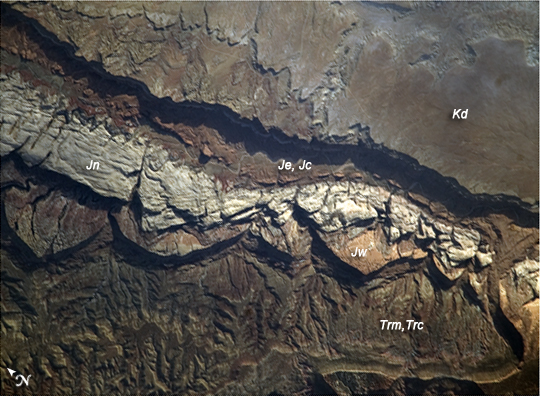
 Photo #: ISS020-E-9861 Date: Jun. 2009
Photo #: ISS020-E-9861 Date: Jun. 2009Geographic Region: USA-UTAH
Feature: WATERPOCKET FOLD, BIG THOMSON MESA

 Photo #: ISS020-E-9861 Date: Jun. 2009 Photo #: ISS020-E-9861 Date: Jun. 2009Geographic Region: USA-UTAH Feature: WATERPOCKET FOLD, BIG THOMSON MESA |
 |
| Big Thomson Mesa, Capitol Reef National Park, Utah This detailed astronaut photograph depicts a portion of Big Thomson Mesa located near the southern end of Capitol Reef National Park. Capitol Reef National Park is located on the Colorado Plateau, a physiographic and geologic province that comprises the adjacent quarters of Arizona, Colorado, New Mexico, and Utah. Big Thomson Mesa (image upper right) is part of a large feature known as the Waterpocket Fold. The Fold is a geologic structure called a monocline, characterized by generally flat-laying sedimentary rock layers with a steep and highly localized flexure- much like a carpet runner draped over a stair step. Monoclines on the Colorado Plateau are thought to be the result of faulting of stratigraphically lower and more brittle crystalline rocks; while the crystalline rocks were broken into raised or lowered blocks, the overlaying, less brittle sedimentary rocks were flexed without breaking. The portion of the Waterpocket Fold illustrated in this image includes layered rocks formed during the Mesozoic Era (~ 250 - 65 million years ago) - the oldest layers are at the bottom of the sequence (and also, in this view, the image), with each successive layer younger than the preceding one going upwards in the sequence. Not all of the units present are clearly visible, but some of the major units can be easily distinguished. The bottom half of the image includes the oldest rocks in the view: dark brown and dark green Moenkopi (Trm) and Chinle (Trc) Formations. At image center, two strikingly colored units are visible - light red to orange Wingate Sandstone (Jw)and white Navajo Sandstone (Jn). A topographic bench above these units includes reddish brown to brown Carmel Formation (Jc) and Entrada Sandstone (Je). The top of the cliff face above this bench - Big Thomson Mesa - is comprised of brown Dakota Sandstone (Kd). This sequence represents more than 100 million years of deposition. Much younger Quaternary (2.0 million to approximately 10,000 years old) deposits are also present in the view. The area shown in this astronaut photograph is located approximately 65 kilometers to the southeast of Fruita, UT near the southern end of Capitol Reef National Park. |
| Images: | All Available Images Low-Resolution 251k |
|
| Mission: | ISS020 |
|
| Roll - Frame: | E - 9861 |
|
| Geographical Name: | USA-UTAH |
|
| Features: | WATERPOCKET FOLD, BIG THOMSON MESA |
|
| Center Lat x Lon: | 37.7N x 111W |
|
| Film Exposure: | N=Normal exposure, U=Under exposed, O=Over exposed, F=out of Focus |
|
| Percentage of Cloud Cover-CLDP: | 10 |
|
| Camera:: | N3 |
|
| Camera Tilt: | 34 | LO=Low Oblique, HO=High Oblique, NV=Near Vertical |
| Camera Focal Length: | 800 |
|
| Nadir to Photo Center Direction: | SW | The direction from the nadir to the center point, N=North, S=South, E=East, W=West |
| Stereo?: | Y=Yes there is an adjacent picture of the same area, N=No there isn't |
|
| Orbit Number: | 554 |
|
| Date: | 20090614 | YYYYMMDD |
| Time: | 134849 | GMT HHMMSS |
| Nadir Lat: | 39.3N |
Latitude of suborbital point of spacecraft |
| Nadir Lon: | 109.7W |
Longitude of suborbital point of spacecraft |
| Sun Azimuth: | 76 | Clockwise angle in degrees from north to the sun measured at the nadir point |
| Space Craft Altitude: | 183 | nautical miles |
| Sun Elevation: | 20 | Angle in degrees between the horizon and the sun, measured at the nadir point |
| Land Views: | PLATEAU |
|
| Water Views: | |
|
| Atmosphere Views: | |
|
| Man Made Views: | |
|
| City Views: | |
|
Photo is not associated with any sequences | ||
| NASA Home Page |
JSC Home Page |
JSC Digital Image Collection |
Earth Science & Remote Sensing |
|
|